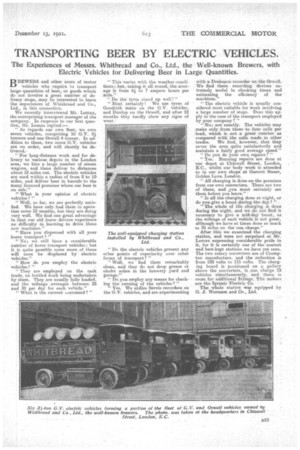TRANSPORTING BEER BY ELECTRIC VEHICLES.
Page 21

If you've noticed an error in this article please click here to report it so we can fix it.
The Experiences of Messrs. Whitbread and Co., Ltd., the Well-known Brewers, with Electric Vehicles for Delivering Bee' in Large Quantities.
pe EENVERS and other users of motor -11-, vehicles who require to transport large quantities of beer, or goods which do not involve a great number of delivery stops, may be interested to learn the experiences of Whitbread and Co., Ltd. in this connection.
We recently interviewed Mr. Lomax, the enterprising transport manager of the company. In response to our first question, Mr. Lomax replied:— " As regards our own fleet, we own seven vehicles, comprising 10 0.11. tonners and one Orwell 4 termer. In addition to these, two more 0.V. vehicles are on order, and will shortly be delivered.: " For long-distanee work and for delivery to various depots in the London area, we hire a large number of steam wagons, and these deliver to distances about 18 miles out. The electric vehicles are used within a radius of from 8 to 10 miles, and deliver beer in barrels to the many licensed premises where our beer is on sale."
"What is your opinion of electric vehicles? " • " Well, so far, we are :perfectly satisfied. We have only had them in eperalion some 12 months, but they are -doing very well. We find one great advantage in that our old horse drivers experience no difficulty in learning to drive these now machines."
"Have you dispensed with all your horse transport ?
" No; we still have a considerable number of horse transport vehicles; but it is quite possible some more of these will soon be displaced by electric vehicles."
"How de you employ the electric vehicles? "
" They are employed on the cask trade no bottled work being undertaken by them. They are usually fully loaded, and the mileage averages between 25 and 30 per day for eaeh vehicle." " What is the current eonsumedI " " This varies with the weatherconditions; hut, taking it all round, the average is from 4 to 7 ampere hours per mile."
Do the tyres stand up well?"
" Most certainly! We use tyres of Goodrich make on the G.V. vehicles, and Dunlop on the Orwell, and alter 12 months they hardly show any signs of wear.'
"Do the electric vehicles ,present any other points of superiority over other forms of transport ? " " Well, we find them remarkably clean, and they do not drop grease or cinder ashes in the brewery yard and garage."
Do you employ any means for checking the running of the vehicles ? " " Yes. We utilize Sea-vie recorders an the G.V. vehicles, and are experimenting
with a Drakevin recorder on the Orwell. We find these recording devices extremely useful in checking times and estimating the efficiency of the machines."
" The electric vehicle is usually considered most suitable for work involving a large number of etops. 'Does this apply in the case of the transport employed by your company ? "
"No; not exactly. The vehicles may make only from three to four calls per load, which is not a great number as compared with the calls made in other
trades. We find, however, that they cover the area quite satisfactorily and maintain a fairly good average speed." " Do you do your own repairs ? "
" Yes. 'Ruin/mg repairs are done at our depot at Chiswell Street, London, E.G., whilst our -body work is attended to in our own shops at Garrett &Feet, Golden Lane, London.
"All charging is done on the premises from our own converters. 'There are two of .these, and ,you must certainly see them before you leave." ' " Is all the charging done at-night, or do you give a boost during the day ? " "The whole of the charging is done during the night, and we do not find it necessary to give a mid-day boost, as the mileage of each vehicle is not great, although we have at times done as much as 35 miles on the one charge."
After this we examined the charging station, and -were not surprised at Mr. Lomax expressing considerable pride in -it, for it is certainly one of the neatest and best-kept stations we have yet seen. The two rotary converters are of Crampten manufacture, and the reduction is from 530 volts to 115 volts. The charging board is positioned on a gallery above the converters, it can charge 12 vehicles simultaneously, and there is room for additional fittings, The makers are the Igranie Electric :Co. The whole station was equipped by G. J. Worssam and Co., Ltd.
































